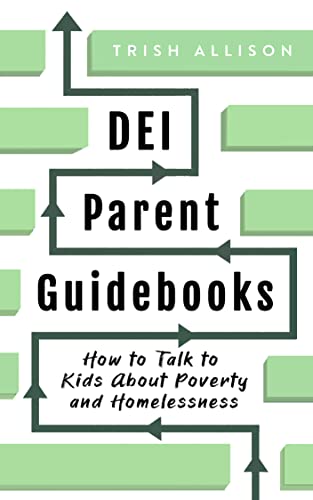Review of How to Talk to Your Kids About Poverty and Homelessness, by Trish Allison
“Whatever you choose to say, say something.”
These words, from Chapter 2 of Trish Allison’s How to Talk to Your Kids About Poverty and Homelessness, are what linger with me most after closing her book. The specific topics of this book are poverty and homelessness, but the deeper issue at hand—and where Allison offers her most valuable wisdom—is how we talk to our children about every nuanced and complicated problem. Not just how we talk to them, but how we listen—and not just how we listen, but how we craft the safe spaces that allow our children to open up, examine their feelings, and contemplate new ideas. This volume presents an excellent step-by-step approach for doing exactly that.
In terms of content, the book focuses heavily on homelessness as a child might witness it on a city street. Less attention is paid to the pervasive poverty of working-class people, who clothe their children and (mostly) manage to keep a roof over their heads, but still endure the chronic stress of exploitative and poorly compensated employment. In that sense, the pairing of the words “poor” and “homeless” may feel jarring to lower-income readers of this book, and some of the indicators of poverty mentioned here—like a child wearing the same dress to school each day—may seem unlikely or outdated.
None of this detracts from the overall usefulness of the volume, which emphasizes repeatedly the important truth that, as parents, we do not have to be experts on American socioeconomic policy in order to help our children make sense of these issues. Rather, Allison tells us, we need to listen, work with our kids to establish a basic understanding of the problem, discuss and debunk stereotypes, and find good answers to common questions about the issues at hand.
Finally, and with sincere eloquence, Allison instructs us to “cultivate respect for poor people at home.” This should be done both in word and in action, ideally enlisting our children in physical activities channeled toward helping less fortunate people, like packing up old clothes to donate, or helping at a soup kitchen. For me, mom to an inquisitive and highly kinesthetic learner, this advice resonates deeply. It is easy to bring up a difficult topic of conversation once or twice, but the integration of our words and actions is critical to sustain the dialogue within a household. Allison offers helpful tools for doing just that.
As a diversity coach for parents, I believe the most impactful way to impact our children’s understandings of the world is to teach them how to cultivate deep personal relationships with people who are different from us. While relationship-building isn’t the explicit focus of Allison’s volume, it is an end goal that becomes much more achievable once we learn, within our own families, how to talk, listen, and stand up for change. Little by little, in small action after small action, we can make a real difference. “Whatever you choose to say, say something,” Allison reminds us, and after reading her book, every reader will be prepared to do just that.

